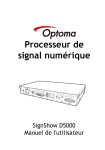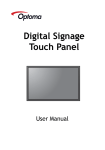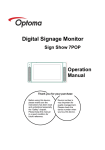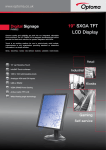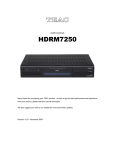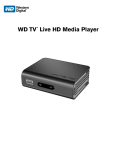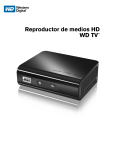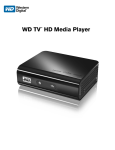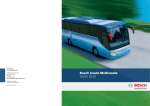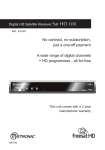Download Optoma SignShow D5000
Transcript
Digital Signage Processor SD AUDIO 12V RES ET IN AUDIO OUT VIDEO IN DVI USB LAN WIRE IR RS 23 2 SignShow D5000 User Manual Table of Contents Safety Instructions iv Power Cord & adapter Warnings .............................................. iv Technical Support ...................................................................... v Declaration of Conformity vi FCC Notice ............................................................................... vi This device complies with part 15 of the FCC Rules. Operation is subject to the following two conditions: ........................................................vi WEEE Notice ........................................................................... vii Introduction 1 Overview .................................................................................... 1 Features ...................................................................................... 2 Package Contents ....................................................................... 3 Connectors View ........................................................................ 4 Remote Control .......................................................................... 5 Getting Started 6 Setting up New SD Card Content .............................................. 6 Connecting the Power ................................................................ 6 Inserting the SD Card ................................................................. 6 Removing the SD Card .............................................................. 8 Making Connections .................................................................. 8 Connecting to a Monitor ....................................................................8 Connecting USB devices ...................................................................8 Connecting to a Network ...................................................................9 Connecting Speakers .........................................................................9 Connecting a DVD player or TV STB ............................................10 LED Indicator .......................................................................... 11 Menu 12 Date and Time .......................................................................... 12 Network .................................................................................... 13 Program .................................................................................... 14 Previewing a Program ......................................................................15 Timer ........................................................................................ 15 Language .................................................................................. 16 Video Out ................................................................................. 17 i Table of Contents Play Mode ................................................................................ 18 Schedule ...........................................................................................19 S-Video ............................................................................................19 Network Streaming ..........................................................................19 Slide Show .......................................................................................19 Video Repeat ...................................................................................21 Memory Card ........................................................................... 21 IR Control ................................................................................ 22 To lock the remote control ...............................................................22 To unlock the remote control ...........................................................23 Hidden Menu ........................................................................... 23 Upgrade .................................................................................... 24 Upgrading System Driver: ...............................................................24 Content Update Mode from USB memory: .....................................25 System ...................................................................................... 26 How to Use the Digital Signage Processor 28 Powering On ............................................................................ 28 Powering Off ............................................................................ 28 Playing media files using USB memory .................................. 29 Playing media files on the SD card .......................................... 29 Updating Content ..................................................................... 29 USB Memory Update ......................................................................30 Manual rewrite of SD card by PC ....................................................31 Rewrite through LAN ......................................................................31 Rewrite through WAN .....................................................................32 Specifications 33 Internal Storage ........................................................................ 33 SD card structure .............................................................................33 Configuration File .................................................................... 33 Supported Image Formats ........................................................ 34 Supported Video and Audio Formats ...................................... 34 Video and Audio Specifications ......................................................35 ii Software Layout Utility ........................................................... 37 Layout Template ...................................................................... 38 Software Limitations ................................................................ 42 Table of Contents Video Input .............................................................................. 43 Hardware Specifications .......................................................... 45 Tr ou ble sho ot ing 47 Error Messages ......................................................................... 47 FAQ’s ....................................................................................... 48 iii Safety Instructions & Warranty Safety Instructions Use the following safety guidelines to help protect yourself and your Digital Signage Processor. • • Do not attempt to service the Digital Signage Processor yourself. Always follow installation instructions closely. To avoid personal injury from electric shock or fire: • • • • Completely power down the Digital Signage Processor when cleaning the Digital Signage Processor, its components, or chassis, or performing operations requiring similar steps. To do this, first turn the power off, then disconnect the AC adapter from the electrical outlet or from any other type of external power source. Do not operate the Digital Signage Processor near water, for example, near a kitchen sink or laundry tub, in a wet basement, by a swimming pool, or in the rain. Do not push objects into air vents or openings of your Digital Signage Processor. Doing so can short out interior components and may cause fire or electric shock. Operate the Digital Signage Processor at the recommended temperature range of +0°C to +40°C (+32°F to +104°F). Store it at a temperature of -10°C to +60°C (+14°F to +140°F). Power Cord & adapter Warnings • See the Installation Instructions before connecting to the power supply. • Be sure that the power outlet you plug the power cord into is easily accessible and located as close to the equipment operator as possible. • When using your power cord, make sure to position it around objects so it is not cut or punctured. • Use only the power cord provided for use with this Digital Signage Processor in accordance with the table below. Plug Type iv Country U.S.A. /Canada EU (except U.K.) U.K. Voltage 120* 230 230 * When operating the Digital Signage Processor with its AC 125-240V power supply, use a power supply cord that matches the power supply voltage of the AC power outlet being used. Safety Instructions & Warranty • Before you connect the Digital Signage Processor to a power source, ensure that the voltage rating of the AC adapter matches that of the available power source. • • • • 115 V/60 Hz in most of North and South America and some Far Eastern countries such as South Korea and Taiwan. 100 V/50 Hz in eastern Japan and 100 V/60Hz in western Japan. 230 V/50 Hz in most of Europe, the Middle East, and the Far East. If you use an extension cable with your AC adapter, ensure that the total ampere rating of the products plugged in to the extension cable does not exceed the ampere rating of the extension cable. • Do not cover the AC adapter with papers or other items that may reduce cooling; also, do not use the AC adapter while it is inside a carrying case. • To remove power from the Digital Signage Processor, turn it off and disconnect the AC adapter from the electrical outlet. • The plug is the disconnecting device. Warranty We warrant that each of our products will be free from material and workmanship defects for two years from the date of purchase. If the customer discovers a defect, contact your dealer. Defective products will be repaired or replaced at no charge to the customer, provided it is returned during the warranty period of two years. This warranty does not apply to any products which have been repaired or altered by persons other than authorized repair personnel, or which have been subject to misuse, abuse, accident or improper installation. We assume no liability under the terms of this warranty as a consequence of such events. Technical Support For technical support and service, please contact your dealer or visit the website indicated at the back of the warranty card. v Declaration of Conformity Declaration of Conformity FCC Notice This equipment has been tested and found to comply with the limits for a Class B digital device, pursuant to part 15 of the FCC Rules. These limits are designed to provide reasonable protection against harmful interference in a residential installation. This equipment generates, uses and can radiate radio frequency energy and, if not installed and used in accordance with the instructions, may cause harmful interference to radio communications. However, there is no guarantee that interference will not occur in a particular installation. If this equipment does cause harmful interference to radio or television reception, which can be determined by turning the equipment off and on, you are encouraged to try to correct the interference by one or more of the following measures: • • • • Reorienting or relocating the receiving antenna. Increasing the separation between the equipment and receiver. Connecting the equipment into an outlet on a circuit different from that to which the receiver is connected. Consulting the dealer or an experienced radio or television technician for help. This device complies with part 15 of the FCC Rules. Operation is subject to the following two conditions: 1. This device may not cause harmful interference, and 2. This device must accept any interference received, including interference that may cause undesired operation. CE Marking This product complies with the principal elements of the safety objectives of EMC Directive (2004/108/EEC) and the Low Voltage Directive (2006/95/EC) issued by the Commission of the European Community. Compliance with these directives implies conformity to the following European Norms (in parentheses are the equivalent international standards and regulations): vi • EN55022 (CISPR 22). Electromagnetic Interference • EN55024 (IEC61000-4-2,3,4,5,6,8,11). Electromagnetic Immunity • EN61000-3-2. (IEC61000-3-2)-Power Line Harmonics Declaration of Conformity • EN61000-3-3. (IEC61000-3-3)-Power Line Flicker • EN60950 (IEC60950). Product Safety Japanese Notice WEEE Notice • • The Directive 2002/96/EC on Waste Electrical and Electronic Equipment (WEEE) which entered into force on 13th February 2003, is to ensure that WEEE are recycled using best available treatment, recovery and recycling techniques in order to protect human health and natural resources. Recycling & disposal: • • • Do not dispose of your product which has the WEEE logo (shown as right) on it or on its box in the general household waste bin. Be sure to dispose of all your products in the designed collection facilities for recycling of such hazardous wastes. Separate collection and proper recovery of your WEEE at the time of disposal will allow us to help conserve natural resources. Moreover, proper recycling of WEEE will ensure safety of human health and environment. For more information about WEEE disposal, recovery, and collection points, please contact your local city center, household waste disposal service, retailer or manufacturer of the equipment. vii Introduction Introduction Overview Thank you for purchasing your Digital Signage Processor. This Digital Signage Processor is a powerful digital engine for high quality video and graphics. It can perform live broadcasts, video/audio files, and display tickers. You can easily control, schedule and deliver multimedia content through network input. Easily update and change display contents in real time by connecting to the server. Its compactness allows for easy integration with PDP’s (Plasma Display Panel), LCD monitors and televisions. Multiple zones and layouts make this product capable of creating vivid and captivating multimedia content to attract more attention. Your Digital Signage Processor uses standard media files, providing a reliable and easy-to-use platform. Read this chapter to learn more about the features of your Digital Signage Processor. 1 Introduction Features • High Performance. Full HD (1080P) output with hardware video/audio decoder, supports up to 2 videos / 2 graphics/ 2 tickers. • Compact. The compact and rugged case design makes it easy to mount and install. • Network-Manageable. Your Digital Signage Processor can connect remotely through a Local Area Network. • Web setting. Use your internet browser to set up your Digital Signage Processor through the Web interface. • Content-rich presentation. Supports most standard media files for a content-rich presentation. Video: WMV, MPEG1, MPEG2, MPEG4, VC-1 Audio: MP2, MP3, WMA, M4A Graphics: BMP, JPEG, PING Ticker: text, RSS Clock: Support multiple clock formats. Weather: Showing weather info by RSS feed. • Multi zone layout.This feature allows you to create vivid and more attractive presentations. • Flexible scheduling capability. This feature allows you to display content on an anytime, anywhere basis. • S-Video input (for DVD/TV). Your Digital Signage Processor supports S-video input for DVD and TV. • Standard storage. Your Digital Signage Processor uses an SD card for local storage. • Fanless design. 2 Introduction Package Contents When unpacking, please ensure the following items are included. If any items are missing or damaged, please contact your retailer. IN k Setu Quic AUDIO OUT VIDEO IN DVI USB LAN WIRE nual p Ma SD 12V RESET AUDIO IR RS23 2 Digital Signage Processor Quick Start Manual Remote Control CD ROM Power Adapter SD Card Protector Power Cord AA Battery x 2 DVI-D Cable (optional) B 2G USB Extension Cable (optional) Wired IR (optional) 3MTM double sided tape 4032 22 mm x 14 mm 3 Audio Cable (optional) DVI-I to VGA adapter SD Card 2GB Introduction Connectors View SD 12V RESET AUDIO IN AUDIO OUT VIDEO IN 123 4 5 6 No. Item DVI 7 USB 8 LAN WIRE IR 9 10 11 12 RS232 13 Description 1 Power socket Use to connect to the power adapter 2 Reset button Press to reset the Digital Signage Processor settings 3 Audio In Use to connect to an external device such as a DVD player or STB 4 Audio Out Use to connect to an external device such as TV line-in or speakers 5 SD card slot Use to insert the SD card 6 S-Video In Use to connect to an S-video output from a DVD player, set-top box, etc. 7 DVI-I port Use to connect to a DVI-D or DVI-I cable 8 USB port Use to connect a USB memory drive for updating content/System driver 9 LAN Use to connect to a an ethernet network 10 LED indicator Indicates the status of the Digital Signage Processor 11 IR Sensor Receives incoming remote control commands 12 Wired IR jack Use to connect to a wired IR 13 RS232 port Use to connect to an RS232 cable 4 Introduction Remote Control The Digital Signage Processor comes with a remote control for inputting commands. The diagram and table below show the keys and basic operation of the remote control. POWER ON STANDBY Keypad 1 1 2 3 4 5 6 7 8 9 4 Power button 5 Standby button 6 Menu button 7 Exit button 0 MENU 2 Arrow keys SET SET button 3 EXIT No, 5 Item Description 1 Keypad Press the keys to enter numeric values 2 Arrow keys Press to navigate through menu selections 3 SET button Press to enter or confirm selection 4 Power button Press to power up the Digital Signage Processor 5 Standby button Press to power off the Digital Signage Processor 6 Menu button Press to display the on-screen display (OSD) Menu 7 Exit button Press to exit the menu or submenu options Getting Started Getting Started Setting up New SD Card Content You need to set up the contents of the SD card before using it for the first time. The sample media files and system drivers (libxxx.img) for the SD card content can be found in the included CD-ROM. Use your PC to copy these sample files to the SD card. Connecting the Power 1. Connect the power cord to the adapter. SD 12V RESET AUDIO IN AUDIO OUT VIDEO IN DVI USB LAN WIRE IR RS2 32 SD 12V RESET AUDIO IN AUDIO OUT V IDEO IN DVI USB LAN WIRE IR RS232 2. Connect the power adapter to the power socket of your Digital Signage Processor. 3. Plug the power cord to a live outlet. Inserting the SD Card Before using your Digital Signage Processor, you must insert an SD Card. You can use SD cards up to 16 GB in size. 6 Getting Started 1. Insert the SD card in the card slot with the contacts facing upward. SD 12V RESE AUDIO T IN AUDIO OUT VIDEO IN 2. Slide it until it clicks into place. 3. To protect the SD card from damage or accidental loss, screw the SD card protector onto the case. Refer to the diagram below. SD SD 3a. 12V RESE AUDIO T IN 3b. AUDIO OUT VIDEO Note 12V RESE AUDIO T IN VIDEO IN IN in order to avoid an update function failure, do not lock the SD card. B 2G Write protect lock set to correct position 7 AUDIO OUT Lo ck Getting Started Removing the SD Card 1. Unscrew the SD card protector from the case. 2. Gently push the SD card in until it clicks to release the lock. 3. Remove the card. 4. Screw the SD card protector back. Making Connections Connecting to a Monitor You can connect your Digital Signage Processor to an output display device such as a computer monitor or a projector monitor. You can connect using the DVI-I port. To connect using the DVI-I port 1. Connect one end of the DVI-D cable to the DVI-I port of the Digital Signage Processor. 2. Connect the other end to the DVI-I port of the monitor. SD 12V RESET AUDIO IN AUDIO OUT VIDEO IN DVI USB LAN WIRE IR RS23 2 SD 12V RESET AUDIO IN AUDIO OUT VIDEO IN DVI USB LAN WIRE IR RS232 Connecting USB devices You can connect a USB memory drive using the USB port for content file updates or system upgrades. 8 Getting Started Simply plug in the USB cable of your device to the USB port of the Digital Signage Processor. A USB extension cable is provided with your Digital Signage Processor package for easy access and connection. SD 12V RESET AUDIO IN AUDIO OUT VIDEO IN DVI USB LAN WIRE IR RS23 2 SD 12V RESET AUDIO IN AUDIO OUT VIDEO IN DVI USB LAN WIRE IR RS232 Connecting to a Network For rapid content file updates, connect to InfoSAP Creator. To connect to the network, use the RJ-45 port. Connect one end of the network cable to the RJ-45 port on your Digital Signage Processor and the other end to your network hub or wall socket. SD 12V RESET AUDIO IN AUDIO OUT VIDEO IN DVI USB LAN WIRE IR RS23 2 SD 12V RESET AUDIO IN AUDIO OUT VIDEO IN DVI USB LAN WIRE IR RS232 Connecting Speakers For a more attention-grabbing display, your Digital Signage Processor is capable of playing audio files exported from InfoSAP Creator. 9 Getting Started Connect speakers using the stereo jack on your device. SD 12V RESET AUDIO IN AUDIO OUT VIDEO IN DVI USB LAN WIRE IR RS23 2 SD 12V Note RESET AUDIO IN AUDIO OUT VIDEO IN DVI USB LAN WIRE IR RS232 Audio files must first be edited by using InfoSAP Creator. Connecting an Audio In Component Your Digital Signage Processor supports component Audio-in from devices such as a DVD player or set-top box (STB). Connecting a DVD player or TV STB For vivid media content, you can play back video files directly from your DVD player or TV STB. 1. Connect the Mini DIN 4-pin cable to the Video-in socket of your Digital Signage Processor. 2. Connect the other end to a DVD player or TV STB. 3. Select S-video Mode in the Play Mode submenu. See “Play Mode” on page 18 for details. SD 12V RESET AUDIO IN AUDIO OUT VIDEO IN DVI USB LAN WIRE IR RS23 2 SD 12V RESET AUDIO IN AUDIO OUT VIDEO IN DVI USB LAN WIRE IR RS232 10 Getting Started Note Media content must first be edited using InfoSAP Creator. LED Indicator The LED indicator indicates the status of your Digital Signage Processor. USB LAN WIRE LED Indicator LED Indicator 11 IR RS23 Status Green Power is on Red On standby mode Green, blinking Preparing to standby 2 Menu Menu The Menu consists of menu options for your Digital Signage Processor. Press Menu. MENU on the remote control to activate the DATE/TIME NETWORK PROGRAM TIMER LANGUAGE VIDEO OUT PLAY MODE MEMORY CARD IR CONTROL Press to change select. Press [Set] to enter submenu. Press the Up/Down arrow keys to move through the menu. Press SET to enter a menu item. To exit the menu, press MENU or To exit a submenu option, press EXIT . EXIT . Date and Time Within the Date/Time submenu, you can: • Manually set the date and time of your Digital Signage Processor • Sync the date and time via Network Time Protocol (NTP) • Enable/Disable daily synchronization to NTP • Set the Time Zone 12 Menu Press MENU > Date/Time. DATE/TIME NETWORK PROGRAM TIMER LANGUAGE VIDEO OUT PLAY MODE MEMORY CARD IR CONTROL Date: Time: mm/ dd / yyyy 01 / 01 / 2008 hh : mm : ss 00 : 00 : 00 NTP Server: 220 . 130 . 158 . 51 Sync Time Everyday Time Zone Sync Apply to setup the system date/time and time-synchronization Press [Exit] to return. • Use the arrow keys on the remote control to move through the selections. • Press the keypad to enter numeric values. • Select Apply to save and apply changes. Network 13 You can update the content of your storage card by connecting to DS-Server or InfoSAP Creator. Set up your Digital Signage Processor to connect to the server in the Network submenu. The Network submenu allows you to configure your Digital Signage Processor for the network. You can: • Set network configuration • Set proxy • Set DNS • Set DS-Server • View the MAC address By default, the network is set to DHCP. When DS-Server is set up, the Digital Signage Processor connects periodically with the server to report current status or settings. You can Menu also remotely control the Digital Signage Processor from DS-Server. Press MENU > Network. DATE/TIME NETWORK PROGRAM TIMER LANGUAGE VIDEO OUT PLAY MODE MEMORY CARD IR CONTROL Static IP 196.168.1 .225 IP: Netmask: 255.255.255 .0 Gateway: 196.168.1 .254 211.78 .130 .2 DNS: 00:16:E8:F1:94:7E MAC: Proxy DS-Server Select type of connection: DHCP or Static IP Select this option to enter proxy IP settings. Apply to setup the network configuration Press [Exit] to return. When you select the “Static IP” option, the IP, Netmask, Gateway, and DNS are enabled. Enter the necessary information. • Use the arrow keys on the remote control to move through the selections. • Press the keypad to enter numeric values. • Select Apply to save and apply changes. Program The Program submenu lists the program contents in your storage card. The programs are listed in order of filename. In Preview mode, you can preview selected programs. 14 Menu Previewing a Program DATE/TIME NETWORK PROGRAM TIMER LANGUAGE VIDEO OUT PLAY MODE MEMORY CARD IR CONTROL Program List: DemoCase.xml List of the program contents in your storage card. 1/1 to preview a program Press [Exit] to return. Press to change page when on the list. • Use the Up/Down arrow keys to move through the program list. • To change the page, use the left/right arrow keys. Press SET to select and play the file. Timer You can set the timer settings of your Digital Signage Processor in the Timer submenu. You can: • Enable daily timers • Set timers to power on or power off your device • Set timers to turn the video on or off 15 Menu Press MENU > Timer. DATE/TIME NETWORK PROGRAM TIMER LANGUAGE VIDEO OUT PLAY MODE MEMORY CARD IR CONTROL Enable Daily Timer Power-On Power-Off Video-On Video-Off mm / dd 01 / 01 01 / 01 01 / 01 01 / 01 hh : mm 00 : 00 00 : 00 00 : 00 00 : 00 Apply to set the timer Press [Exit] to return. • Use the arrow keys to move through the options. • Press to enable a timer. • Use the keypad to enter numeric values. • Select Apply to save and apply changes. SET Language Press MENU > Language. DATE/TIME Select Language: Your Digital Signage English NETWORK Deutsch PROGRAM Processor supports TIMER Français English, German, LANGUAGE Español VIDEO OUT French, Spanish, PLAY MODE Japanese,Traditional MEMORY CARD IR CONTROL Chinese and Simplified Chinese for its onscreen display language. to set the language Press [Exit] to return. The default language is English. You can change the language in the Language submenu. 16 Menu Video Out In the Video Out submenu, you can: • Select the video output resolution through DVI, Digital Video, VGA • Set to read video frequency from the connected display MENU Press > Video Out. Select Video Output Mode DATE/TIME NETWORK PREVIEW TIMER LANGUAGE VIDEO OUT VIDEO IN MEMORY CARD IR CONTROL SLIDE SHOW Current Mode: VGA 1024X768@60 Select Video Output Mode: DVI Digital Video VGA to set the video output timing Press [Exit] to return. The supported video output resolutions are as follows: DVI • • • • • • 1920 x 1080 / 60 Hz, VESA timing 1680 x 1050 / 60 Hz, VESA timing 1360 x 768 / 60 Hz, VESA timing 1280 x 1024 / 60 Hz, VESA timing 1024 x 768 / 60 Hz, VESA timing 640 x 480 / 60 Hz, VESA timing Digital Video 17 • 1080P /60 Hz • 1080i /60 Hz • 720P /60 Hz Menu • 640 x 480 / 60 Hz VGA • 1680 x 1050 / 60 Hz, VESA timing • • • • 1360 x 768 / 60 Hz, VESA timing 1280 x 1024 / 60 Hz, VESA timing 1024 x 768 / 60 Hz, VESA timing 640 x 480 / 60 Hz, VESA timing The default video output resolution is set at 1024 x 768 @ 60Hz, VGA timing. Note • When changing the output timing, you must make sure you have the correct cable attached and then press numeric key “1” on the remote control within 45 seconds. Otherwise, the settings revert to the original output timing. • VGA timing requires a DVI to VGA cable connection. Play Mode You can select the Play mode in the Play Mode submenu. Press MENU > Play Mode. DATE/TIME NETWORK PROGRAM TIMER LANGUAGE VIDEO OUT PLAY MODE MEMORY CARD IR CONTROL Select Play Mode: Schedule S-Video Network Streaming Slide Show Video Repeat Apply to set the play mode Press [Exit] to return. Use the arrow keys on the remote control to move through the selections. 18 Menu Schedule Schedule is the default mode. Select Schedule mode to play a program with the scheduling function. S-Video You can also select S-Video mode to play back video files directly from your DVD player or TV STB. Network Streaming You can also select Network Streaming mode to get video files through the LAN. You can configure the streaming server by entering the server IP and Port address. DATE/TIME NETWORK PROGRAM TIMER LANGUAGE VIDEO OUT PLAY MODE MEMORY CARD IR CONTROL Select Play Mode: Schedule S-Video Network Streaming Slide Show Video Repeat IP: 227 .40 .50 .60 Port: 8192 Apply to set the play mode Press [Exit] to return. Slide Show Configure the slide show mode in the Play Mode submenu. 19 Menu Press MENU > Play Mode > Slide Show. DATE/TIME NETWORK PROGRAM TIMER LANGUAGE VIDEO OUT PLAY MODE MEMORY CARD IR CONTROL Select Play Mode: Schedule S-Video Network Streaming Slide Show Video Repeat Display Time per Slide: Folder: /. 3 Seconds Apply to set the play mode Press [Exit] to return. The content files supported for a slide show are: BMP, JPEG, PNG. You can set the display time from 3 to 60 seconds per slide using the arrow keys to move the slider. The default value is set to 3 seconds. The slide show is displayed repeatedly. Note The system needs to restart before the Slide Show mode settings can take effect. In Slide Show mode, when you power on the Digital Signage Processor, the processor checks the USB memory and reads image files to start the show. If there is no USB memory detected, it displays a message Please insert USB memory. The slide show content is displayed in alphabetical order using the first character of the file name. The images are resized to full screen while retaining the aspect ratio. 20 Menu Video Repeat You can also select Video Repeat mode to repeatedly play video files from USB memory. DATE/TIME NETWORK PROGRAM TIMER LANGUAGE VIDEO OUT PLAY MODE MEMORY CARD IR CONTROL Select Play Mode: Schedule S-Video Network Streaming Slide Show Video Repeat Screen Size Full Screen Folder: /. Normal Apply to set the play mode Press [Exit] to return. In Video Repeat mode, when you power on the Digital Signage Processor, the processor checks the USB memory and reads image files to start the show. If there is no USB memory detected, it displays a message Please insert USB memory. Note Note Do not unplug the USB memory or SD card during Play Mode. In case this happens, go to Standby mode and reboot the Digital Signage Processor. See “Powering On” on page 28. The system needs to restart before the Slide Show and Video Repeat modes settings can take effect. Memory Card You can see the capacity of your SD card and delete all stored content in the Memory Card submenu. 21 Menu Press MENU > Memory Card. DATE/TIME NETWORK PREVIEW TIMER LANGUAGE VIDEO OUT VIDEO IN MEMORY CARD IR CONTROL SLIDE SHOW Memory Card: 1.9GB 1.8GB Free Available Delete All Content Files to manage the Memory Card storage space Press [Exit] to return. Note Choosing “Delete All Content Files” deletes all content files in your SD card. IR Control IR Control refers to the remote control that is included with your Digital Signage Processor. In the IR Control submenu, you can lock the remote control to prevent unauthorized users from operating your device. Press MENU > IR Control. DATE/TIME NETWORK PROGRAM TIMER LANGUAGE VIDEO OUT PLAY MODE MEMORY CARD IR CONTROL Select IR Mode: Normal IR Lock Apply to set the IR mode Press [Exit] to return. To lock the remote control 1. 2. 3. 4. Highlight IR Lock using the arrow keys on the remote control. Press SET to select. Select Apply. A message appears to confirm disabling of remote control. Select Yes to confirm. 22 Menu To unlock the remote control 1. Press the following keys on your remote control in order: MENU 1 2 3 2. The message “OSD Menu Unlock” is displayed on the screen to confirm unlocking of the remote control. Hidden Menu The Hidden Menu is used to upgrade the contents of your storage device, display system settings, change passwords and restore factory defaults. To protect the contents and settings of your Digital Signage Processor, the Hidden Menu is not displayed on the screen unless you activate it. There are two level Hidden Menus, in simple hidden memu, only system driver can be upgraded; in complex one, you can upgrade all system driver, loder, kernel and splash. To display the simple Hidden Menu, press the following keys in order: MENU SET To display the complex Hidden Menu, press the following keys in order: MENU SET The Hidden Menu consists of two submenus: • Upgrade • System The picture below shows the activated hidden menus. 23 Hidden Menu consists of the Upgrade and System submenu DATE/TIME NETWORK PROGRAM TIMER LANGUAGE VIDEO OUT PLAY MODE MEMORY CARD IR CONTROL UPGRADE SYSTEM Player Name: DS34c2e8d0 Device Name: F/W Version: DS34c2e8d0 System Driver -- V8.17 Kerlen -- V4.1 Loader -- V4.3 MCU -- V4.2 Factory Reset Change Password to show the system information Press [Exit] to return. Menu To deactivate the Hidden Menu, turn off your Digital Signage Processor. The Hidden Menu is not displayed on the screen on your next power up. Upgrade Press MENU > Upgrade. DATE/TIME NETWORK PROGRAM TIMER LANGUAGE VIDEO OUT PLAY MODE MEMORY CARD IR CONTROL UPGRADE SYSTEM Select Upgrade File: System Driver Loader Kernel Splash Content Update Mode from USB Memory: Difference Write Write after Delete Auto Content Update to upgrade the firmware Press [Exit] to return. Use the Upgrade submenu to upgrade system files in your Digital Signage Processor. Your Digital Signage Processor contains four files: System driver, Loader, Kernel, Splash. To select an item, highlight the option by moving the arrow keys on the remote control then press . SET Upgrading the System Driver: 1. Select the file to update by moving the arrow keys to highlight the file then press . 2. Insert the USB memory to the USB port.The Digital Signage Processor automatically checks the USB memory for update files. If no file is found, a “no file” message appears on the screen. Otherwise, the screen displays a list of available system driver. SET 24 Menu Please refer to the picture below. DATE/TIME NETWORK PROGRAM TIMER LANGUAGE VIDEO OUT PLAY MODE MEMORY CARD IR CONTROL UPGRADE SYSTEM Select library in the USB memory: lib-ds-player_0623.img to upgrade the firmware Press [Exit] to return. 3. Select the system driver then press SET . 4. When the message appears on the screen, select “Yes” and press SET to start. It will start upgrading. Do you want to continue? Yes 5. The Digital Signage Processor starts upgrading and displays a message. 6. When the upgrade is complete, a message appears on screen and the Digital Signage Processor reboots. No Upgrading... Please do not power-off. Upgrading is finished. System will reboot now. Content Update Mode from USB memory: Set up the content update mode in this section. Select Difference Write or Write after Delete. When the Digital Signage Processor boots up, it checks the USB memory first. If you set Difference Write mode, only files with different time/date stamps or new files inlcuded on the USB memory but not on the SD card are updated. Files on the SD card but not on the USB card are deleted. If you set Write after Delete mode, all content files in the media folder are deleted. The content files in the USB memory are then copied to the SD card. 25 Menu Auto Content Update: Select/deselect “Enable Auto Content Update” to enable/ disable daily auto content update. Once you enable auto content update, you will see the following detail configuration: • FTP server/Folder: The content directory on FTP. • User: The user name for login FTP. • Password: The password for login FTP. • Time: The dail updated time. Regarding how to set the auto content update configuration, please refer to the InfoSAP Creator manual. System The System submenu displays system settings and manages setup options. You can: • Reset your Digital Signage Processor to its factory settings • Change the password for web access. Press MENU > System. DATE/TIME NETWORK PROGRAM TIMER LANGUAGE VIDEO OUT PLAY MODE MEMORY CARD IR CONTROL UPGRADE SYSTEM Player Name: DS34c2e8d0 Device Name: DS34c2e8d0 F/W Version: System Driver -- V8.17 Kernel -- V4.1 Loader -- V4.3 MCU -- V4.2 Factory Reset Change Password to show the system information Press [Exit] to return. When you select Factory Reset, a confirmation message appears. Select Yes to continue. Warning All settings are erased if you select Factory Reset. 26 Menu A password is required for web access. To set up a password, select Change Password. DATE/TIME NETWORK PROGRAM TIMER LANGUAGE VIDEO OUT PLAY MODE MEMORY CARD IR CONTROL UPGRADE SYSTEM Change Password for Web Access: (4-8 Characters) New Password: ******** Password Confirm: ******** Apply to change the password for Web access Press [Exit] to return. The password must be a 4 to 8 character numeric string. • Enter a new password. • Re-enter to confirm the new password. • Select Apply. Note 27 Make sure the New Password and Password Confirm are the same to ensure successful change of password. How to Use the Digital Signage Processor How to Use the Digital Signage Processor Powering On Note Before powering on the Digital Signage Processor, insert an SD card into the SD card slot. After performing the necessary connections, you are now ready to power on your Digital Signage Processor. Press on the remote control. The LED indicator lights green to denote power. POWER ON Boot Sequence When you turn on the Digital Signage Processor, it checks the memory drives connected to your device in a particular order, this is called the Boot Sequence. In Slideshow mode, the boot sequence of your Digital Signage Processor is as follows: 1. Checks the USB drive for USB memory drive connections. 2. Checks the SD card content. Note When you accidentally turn on the Digital Signage Processor without any memory card inserted in the device, a “No Signal” message appears on the screen. Press device again. STANDBY on the remote control, then press POWER ON to reboot the Powering Off STANDBY To turn off the Digital Signage Processor, press on the remote control. The LED indicator lights red to denote standby mode. 28 How to Use the Digital Signage Processor Playing media files using USB memory By default, if Slide Show mode is enabled, the Digital Signage Processor first reads the USB memory drive for media content when it boots up. 1. Insert the USB memory drive in the USB slot. 2. Turn on the Digital Signage Processor. The content of your memory drive is displayed on the screen. Note Please refer to “ Slide Slide Show mode. Show” on page 19 for details on how to enable Playing media files on the SD card 1. Insert an SD card into the SD card slot. 2. Turn on the Digital Signage Processor. The device boots up. 3. If there is a schedule program in the SD card, the Digital Signage Processor plays the program content. Otherwise, the screen displays the message, “There is no schedule program at current time”. Note Please refer to the InfoSAP Creator manual for more information about playing content files on the SD card. Updating Content Your Digital Signage Processor supports four methods for content update: • USB Memory Update • Manual rewrite of SD card by PC • Remote rewrite through LAN • Remote rewrite through WAN 29 How to Use the Digital Signage Processor The illustration below shows the different content update methods. PC with InfoSAP Creator PC with InfoSAP Creator ork tw Ne SD SD 12V RESET AUDIO IN AUDIO OUT VIDEO 12V RESET AUDIO IN IN AUDIO OUT VIDEO DVI IN DVI USB LAN USB WIRE LAN IR WIRE RS232 IR RS232 Digital Signage Box Digital Signage Box Digital Signage Server WAN SD 12V RESET AUDIO IN AUDIO OUT VIDEO IN DVI USB LAN WIRE IR RS232 Digital Signage Box PC with InfoSAP Creator USB Memory Update A media folder is required for a USB memory update. It must contain the following three files: • Schedule files (.she) • Program files (.xml) • Media folders (named the same as the .xml file) 30 How to Use the Digital Signage Processor You can create content by using InfoSAP Creator. There are two modes for USB update: 1. Mode 1: Delete and copy mode. All content files in the media folder are deleted. The content files in the USB memory are then copied to the SD card. 2. Mode 2: Differential copy mode. The file name and date of the files in the USB memory and the SD card are compared. Only files with different names and/or dates are copied to the SD card. If there are files in the USB memory and the SD card with the same file name and date, they are skipped. If the files in the SD card do not exist in the USB memory, they are deleted. Manual rewrite of SD card by PC You can create schedules using InfoSAP Creator and by manually rewriting the contents of the SD card using a PC. After creating a schedule via InfoSAP Creator, the following items appear: • Schedule file (.she) • Program file (xml) • Media folder with the same name as the program file. Note Before you start copy, check to make sure your SD card contains a folder named “media”. If not, create “media” folder. Now, manually copy the files to your SD card’s “media” folder using your PC’s copy/paste functions. For more information about creating a schedule, please see the InfoSAP Creator user manual. Rewrite through LAN You can create and upload schedules to Processors via InfoSAP Creator. See the InfoSAP Creator user manual for more information. 31 How to Use the Digital Signage Processor Rewrite through WAN 1. Using DS-Server (optional) You can create schedules via InfoSAP Creator or DS-Server and update them to Processors via a DS-Server device. See DS-Server user manual for more information. DS-Server provides enhanced Internet funcitonality. Contact your channel provider for more information. 2. Auto content update You can set auto content update to Processors via InfoSAP Creator. See the InfoSAP Creator user manual for more information. 32 Specifications Specifications Internal Storage The Digital Signage Processor uses an SD card for internal storage. The SD card must have only one FAT32 partition. Your Digital Signage Processor supports SD cards with capacities up to 16GB. SD card structure The SD card must have the following files and folders: 1. System Driver (.img), includes: • Applications • Libraries • Upgrader 2. Media folder, contains: • Only one Schedule file (.she) • One or more set of Program File and Program Folders. • Each Program File has one (.xml) file and one folder, respectively • Program Folders may include the following: • still image file, video file, ticker data (.rss) font (.ttf) 3. Config folder. This folder is automatically created. 4. Ds-player folder. This folder is automatically created. 5. Upgrade folder. This folder is automatically created. Configuration File 33 The configuration file is formatted in XML and named config.dat. If a config.dat file is present in the inserted USB memory, the settings are read during boot-up. The device then reboots for the settings to take effect. Specifications Supported Image Formats The Digital Signage Processor supports BMP, PNG, and JPEG image file formats. • BMP (*.bmp): 24-bpp, R8-G8-B8 • PNG (*.png): 24-bit RGB • JPEG (*.jpg, *.jpeg) Image resolution should be less than 2047 x 2047. Supported Video and Audio Formats Please refer to the table below for video and audio formats supported by the Digital Signage Processor. Table 1: Supported Video and Audio Format Group WMV MPEG-1 MPEG-2 MPEG-2 Video(V) Audio(A) Codec V Windows Media Video 9 V Windows Media Video 9 Advanced Profile A Windows Media Audio 9 V MPEG-1 Video A MPEG-1 Audio layer 2 V MPEG-2 Video A MPEG-1/2 Audio layer 2 A MPEG-1/2 Audio layer 3 V MPEG-2 Video (Transport Stream) A MPEG-1/2 Audio layer 2 A MPEG-1/2 Audio layer 3 Container File Extension ASF .WMV, .ASF MPG .MPG MPG, M2P .MPG, .M2P M2V .M2V TS .TS 34 Specifications Table 1: Supported Video and Audio Format Group MPEG-2 MPEG-4 MPEG-4 MPEG-4 VC-1 Video(V) Audio(A) Codec V MPEG-2 Video (Program Stream) A MPEG-1/2 Audio layer 2 A MPEG-1/2 Audio layer 3 V DivX 5.0 A MPEG-1/2 Audio layer 2 A MPEG-1/2 Audio layer 3 V H.264 A AAC V MP4 A AAC V VC-1 Container File Extension VOB .VOB DivX, AVI .DivX, .AVI MOV, AVI, TS .MOV, .AVI, .TS MP4 .MP4 TS .TS Video and Audio Specifications 1. Windows Media Video 9 (WMV3) • Supports MP@HL (Main Profile, High Level) up to 1280x720p30 or 1920x1080p25 resolution. • Does not support CP (Complex Profile) • Does not support interlaced mode. • Does not support sprite mode. • Does not support files encoded using WMV9 BETA. • Does not support WMV1 OR WMV2. • Supports elementary video stream bit rate of SDTV (HDTV) up to 20 (35) Mbps. 2. Windows Media Video 9 Advanced Profile (WMVA, VC-1, WVCI) 35 Specifications • Supports MP@HL (Main Profile, High Level) up to 1280x720p30 or 1920x1080p25 resolution. • Supporst AP@L3 (Advanced Profile, L3 Level) up to 1920x1080i25, 1920x1080p25 or 1280x720p60 resolution • Does not support CP (Complex Profile) • Does not support interlaced mode. • Does not support sprite mode. • Does not support files encoded using WMV9 BETA. • Does not support WMV1 OR WMV2. • Supports elementary video stream bit rate of SDTV (HDTV) up to 20 (35) Mbps. 3. MPEG-2 Video (MP2V, MPV2, MP2P, MP2T) • Supports MP@HL (Main Profile, High Level) up to 1920x1080p25, 1920x1080i30 or 1280x720p60 resolution. • Supports low delay mode (no B pictures, no frame reordering delay, handling of VBV underflow). • Supports an elementary video stream bit rate for SDTV (HDTV) up to 20 (35) Mbps. 4. DivX 5.0 (DX50), MP4 (MP4V), H.264 • Supports BP@L3 (Baseline Profile, L3 Level) up to 720x480p30 or 720x576p25 resolution, including FMO and ASO. • Supports [email protected] (Main Profile, L4 Level) up to 1920x1080p25, 1920x1080i30 or 1280x720p60 resolution. • Supports [email protected] (High Profile, L4 Level) up to 1920x1080p25, 1920x1080i30 or 1280x720p60 resolution. • Supports up to 180 Mbit/s for CABAC streams. • Supports up to 135 slices per frame. • Supports an elementary video stream bit rate for SDTV (HDTV) up to 20 (35) Mbps. 5. MPEG-1/2 Audio layer 2, MPEG-1/2 Audio layer 3 • • • • • Layer 2: supports bit rates up to 384kbps. Layer 3: supports bit rates up to 320kbps. Supports up to 2.0 channels Supports 16-bit and 24-bit samples. Supports sampling rates of 32, 44.1 and 48 kHz. 6. Windows Media Audio 9 (WMA3, codec id:0x161), Windows Media Audio 9 Professional (codec id:0x162) 36 Specifications • Supports up to 2.0 Windows Media Audio 9 channels. • Supports up to 5.1 Windows Media Audio 9 Professional channels. 7. AAC (MPEG-4 AAC) • • • • • Supports LC (Low Complexity profile). Supports bit rates up to 384kbps. Supports up to 5.1 channels. Supports 16-bit and 24-bit samples. Supports sampling rates of 32, 44.1 and 48 kHz. 8. Streaming • Video: MPEG1, MPEG2. • Audio: MPEG-1 Audio Layer 1/2/3 Software Layout Utility A software layout utility called InfoSAP Creator (included with the CD-ROM) is included when you purchase your Digital Signage Processor. This windows application is used to create programs and schedules for your Digital Signage Processor. With this software, you can specify the layouts and content files to play back. It allows you to do the following: • Define layouts using default layout templates or blank layouts • Assign content to layouts • Create signage • Preview layouts • Create schedules • Upload schedules through LAN/WAN • Set auto upload parameters • Specify video rotation 37 Specifications For more information, please check the software’s User Manual inlcuded in the CD-ROM. Note You can purchase DS-Server for more powerful Internet functionality. Layout Template The Digital Signage Processor supports different types of layouts. Following are some examples: • Image only • Image + Ticker • Video + Ticker • Video + Image + Ticker • Portrait You can also manually add layers. Image Only In an Image only layout, images are shown on screen in Loop play mode. Audio files can be played at the same time. Image + Ticker In an Image + Ticker layout, there is no character quantity limitation. The ticker, (in Unicode characters), runs from right to left, or can have sentences scrolling upward or 38 Specifications downward. Images and the ticker can be overlapped. Audio files can be played at the same time. No overlap. Overlapped. Image and ticker are transparent. Video + Ticker A layout can contain a video file and a ticker. The video file can be from an SD card, S-Video input, or network streaming (See and follow steps 1-3 of “ Manual rewrite of SD card by PC” on page 31 to setup streaming video). The video and the ticker can be overlapped. No overlap. Note Overlapped. Video and ticker are transparent. If you add an audio file and a video file, the audio source is set to audio automatically. The video file’s audio track will not be audible. Video + Image + Ticker 39 A layout can contain a video file, an image and a ticker. The video file can be from an SD card, S-Video input, or network stream. Specifications Note If you add an audio file and a video file + image+ticker , the audio source is set to audio automatically. The video file’s audio track will not be audible. The video, image and ticker can be overlapped. No overlap. Overlapped. Image and ticker are transparent. Portrait Mode In Portrait Mode, only Video, Streaming, Image, and Ticker are supported. The ticker direction is from down to up. There is no character limitation. The ticker font is Unicode. Audio files can be played at the same time. Note • Vertical ticker just supports Chinese, Japanese, and Korea. • If user add a audio file, the audio source will be set to audio automatically. • Before you start copy, check to make sure your SD card contains a folder named “media”. If not, create “media” folder. Now, manually copy the files to your SD card’s “media” folder using your PC’s copy/paste functions. 40 Specifications Video (2) + Image + Ticker The Digital Signage Processor supports playback of 2 videos, an image and a ticker. Possible video combinations inlcude: • Video file + S-Video input • Streaming + S-Video input • Video file + Streaming Vertical Ticker The Digital Signage Processor supports playback of 2 videos, weather images, and 2 tickers. Possible video combinations inlcude: • Video file + S-Video input • Streaming + S-Video input • Video file + Streaming Video Image Window Ticker Video Ticker The processor can play weather from RSS, only Yahoo Weather.rss (http://weather.yahoo.com) is supported. 41 Note Vertical Ticker only supports Chinese, Japanese and Korean. 42 Specifications Software Limitations To ensure the output quality of your Digital Signage Processor, take note of the following software limitations. Media file • The maximum video/audio file size is 4GB. • Two images + Two tickers + Two video files may be shown simultaneously. • If the total of image areas is over 3/4 WXGA: *One image + Two tickers + Two video files may be shown simultaneously. • If WMV or MPEG video bitrate is 6 ~ 16 Mbps: *Two images + One ticker + One video file may be shown simultaneously. • If an H.264 file is inserted: *One image + One ticker + One video file support. • The Maximum URL length for an RSS feed in a program file is 256 bytes. • The maximum font file name length in a program file is 128 bytes. • The Maximum duration of a frame is 24 hours. Note The Program file refers to .xml files. Program file (.XML) • The maximum source number in an item group is 100. • The maximum number of item groups in a frame is 100. • The maximum program name length is 128 bytes. 42 Specifications Schedule file (.SHE) • The maximum number of program and control commands in a scheduling file is 500. Firmware • The maximum firmware filename length is 128 bytes. • The on-screen display only can display 35 files or folders in a directory on the USB drive. Be sure the folder containing the firmware files has fewer than 35 files or folders. Filename: System driver: lib-xxx.img Kernel: knl-xxx.bin Loader: ldr-xxx.bin Splash: sph-xxx.bin Processor name • The maximum processor name length is 64 bytes, alphanumeric. Image / Video quality If an image or video file with 1920 x 1080 resolution is played back on a display with 1920 x 1080 resolution, scaling is not done. Gamma and Luminance Characteristics Gamma and luminance settings can be adjusted using the display function. The Digital Signage Processor is adjusted to display normally on a grayscale test pattern. Video Input 43 There are two video input modes: Normal mode and Full Screen mode. Normal mode has an aspect ratio of 1:1. Specifications The native resolution video input for NTSC is 720 x 480, while PAL is 720 x 576. Normal mode is automatically set for 640 x 480 and 1024 x 768 resolutions. If the resolution is 1920 x 1080, 1360 x 768, 1680 x 1050 or 1280 x 1024, you have to choose between normal and full screen mode. Normal Mode. Aspect ratio of 1:1 (X=Y) Full Screen Mode. You can change the desired mode in the Play Mode submenu. See “ Play Mode” on page 18. 44 Specifications Hardware Specifications Processor CPU: Sigma SMP863X 8 MB Flash memory 256 MB SDRAM DVI: 1920 x 1080 (1080p) / 60hz, VESA timing 1680 x 1050 / 60hz, VESA timing 1360 x 768 / 60hz, VESA timing 1280 x 1024 / 60hz, VESA timing 640 x 480 / 60hz, VESA timing Digital Video: Video Output Resolution 1080P / 60hz 1080i / 60hz 720P / 60hz 640 x 480 / 60hz VGA: 1680 x 1050 / 60hz, VESA timing 1360 x 768 / 60hz, VESA timing 1280 x 1024 / 60hz, VESA timing 1024 x 768 / 60hz, VESA timing (default) 640 x 480 / 60hz, VESA timing Video Input Audio Output Audio Input Network USB Storage interface Storage IR input for remote control 45 Communication interface with display Connector: Mini DIN 7P S video: NTSC / PAL Analog stereo line out Line out L/R x 1, Stereo 3.5 Line in L/R x 1, Stereo 3.5 mini jack mini jack RJ45 x 1 (DHCP, HTTP) No wake on LAN function USB 2.0 Host x 1 USB mass storage class for USB memory only SD card I/F x 1 (SDHC) Max capacity: 16Gbyte SD card 38khz carrier, NEC format signal RS232 (TX and RX), 9 pin x 1 Specifications Wired IR input Power LED Reset button Mini jack: 2.5 (4 pole) Alternative to IR input Operation: GREEN Standby: RED System settings reset AC adapter Input AC 240-100V, 47-63hz Output DC 12V 2.5A Power code Japan, 2 pole, 3.0m Power Consumption Weight Power on: Typ 10W (15W max) Standby: 1W max Net weight: 0.9 kg Gross weight: 2.3 kg Temperature Operating: 0-40 ºC Storage: -10-60 ºC Humidity Operating: 10-80% Storage: 10-90% 46 Troubleshooting Troubleshooting Error Messages This section lists common error messages that may arise during the use of the Digital Signage Processor, and provides answers and solutions to these errors. Error Message • • Check if the SD card is inserted. The SD card may be damaged. Replace it with a new one. System driver not found. Player is recovering system driver now. Please DO NOT turn off the player. • No System Driver is available on the SD card. The Digital Signage Processor is attempting to recover the system driver. Please wait until recovery is complete. Player failed to recover system driver. There is no driver on the SD Card. • Recovery of System Driver failed. Re-copy the System Driver from the CD-ROM to the SD card. • Check to make sure that the memory card contains the necessary media files. Make sure that all program and schedule files are saved under the \media file directory. Player failed to access the SD Card. or Checking SD Card. It failed to access the program file (.xml) SD card is write protected. 47 Solutions • • Please unlock the SD card. Troubleshooting FAQ’s This section lists some frequently asked questions (FAQ) and the answers to these problems. Question Answer Why can’t I view my video files? You may be trying to view a video file that is not supported by the Digital Signage Processor. See “Supported Video and Audio Formats” on page 34. Why can’t I play my music files? You may be trying to play a music file that is not supported by the Digital Signage Processor. See“Supported Video and Audio Formats” on page 34. How do I restore the Digital Signage Processor to its default factory settings? 1. From the Digital Signage Processor OSD Menu>System, select the “Factory Reset” option. 2. Press and hold the reset button and power on the Digital Signage Processor until the LED blinks and stays green. 3. Power off the Digital Signage Processor and press Power on, 7, 8, 5 on the remote controller in sequence. What should I do if the Digital Signage Processor stops functioning or crashes? Press I can’t turn on the device. The batteries on the remote control may be depleted. Replace the batteries. Why the IE shows “Internet Explorer cannot display the webpage” during upgrading system driver by web accessing? 1. Please check the network connection. 2. Retry again once the network connection problem is solved. Why do I see black screen after the Digital Signage Processor boot up? STANDBY and POWER ON on the remote control. 1. After the Digital Signage Processor boot up, press and hold the reset button to check the current output. If the LED flash green light means it is VGA output. If the LED flash orange light means it is DVI output. 2. If you want to switch output between VGA and DVI, click the reset button after the Digital Signage Processor boot up. The LED will be flashing during the output transition. 48
























































